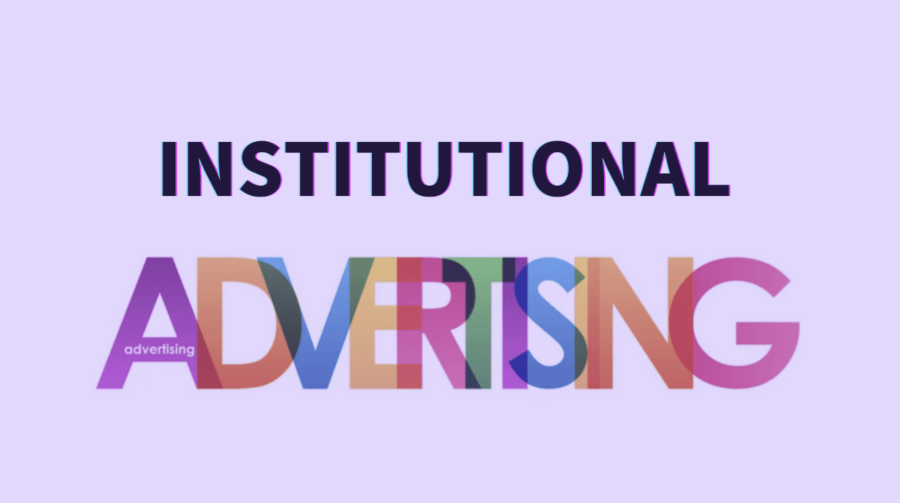Advertising is the key to business success. It can help businesses earn millions once done well, and that’s exactly the reason why almost all companies are committed to investing in advertising.
In an era of information, however, customers and media have evolved and become much more demanding. They are not so easily satisfied with traditional advertising, which requires businesses to take steps to advertise in a more engaged and innovative way.
Institutional advertising is one of the diverse types of advertising available and is a proven way to promote a brand and get recognition before the public.
Today we will cover all you need to know about institutional advertising, including its definition, significance, examples, and so on. Let’s start with the basics now.
What is Institutional Advertising?
Institutional advertising, also known as corporate advertising, is a type of advertising that involves marketing or promoting a company, business, institution, agency, or other similar units.
The main purpose of institutional advertising is to create a positive corporate image and build a good reputation rather than to sell specific products or services. In this case, institutional advertising is closely related to public relations. In other words, institutional advertising can be included in a company’s public relations activities as an important part of its overall marketing strategy.
The medium of institutional advertising can be television, radio, digital media, print media, and etc.
Types of Institutional Advertising
Institutional advertisements are everywhere in our daily life. Generally speaking, institutional advertising can be classified into the following two categories.
- On television and radio
Mainly in the form of commercial and infomercial videos.
- In print and digital media
Mainly in the form of advertisements placed in magazines, newspapers, search engines, social media platforms, emails, websites, and so on.
Institutional Advertisement vs. Product Advertisement
Defining the goal of your advertising campaigns is the first and foremost step of your company marketing strategy. Therefore, it is critical to distinguish between institutional advertisement and product advertisement, know how to launch them, and leverage the two properly.
Product advertisements aim to promote particular goods while institutional advertisements focus on promoting the whole brand. While the two types of ads may sound overlapping, in fact, their ultimate goals are very different.
The main objective of product advertising is to sell as many products or services as possible. It is used to show the features and benefits of the products and usually adopts some promotional tricks such as discounts.
On the other hand, the main objective of institutional promotion is to build brand awareness and credibility in front of the public. Actually, it can be a longer-term strategy for generating sales or leads and disseminate the concept or positioning of the company.
Advantages of Institutional Advertising
There are several reasons for companies to invest in institutional advertising:
-
Raise Brand Awareness
Institutional advertising can help your brand get more exposure and thus increase brand awareness. The greater brand awareness you have, the more audience will be familiar with your product and brand. It also helps the public to understand, recall and be comfortable with your brand.
-
Build Brand Image
Institutional advertising is a good way to build your brand identity. A good institutional advertisement should contain a company’s concept, positioning, mission and values. With it, you can disseminate what you treasure and what you want to present to your consumers and the public.
-
Humanize the Brand
Robotic marketing tactics is not working well anymore. Displaying and maintaining a consistent voice for your brand is important. Institutional advertising is a good way to humanize your brand and make you relatable to your audience. It will also help share your story and build relationships with your audience.
-
Enhance Brand Competitiveness
With institutional advertising, you can create a personality for your brand, differentiate it from others and avoid similarities. It can impress your audience with your unique brand identity, make your brand become top-of-mind when they are going to research and purchase something, and thus make you stand out from your competitors.
Disadvantages of Institutional Advertising
Besides the above advantages, institutional advertising also has some obvious disadvantages. Here are some discussions about it.
- Institutional advertising won’t yield revenue and bring substantial returns on investment in the short run, as it does not promote any product or service offered by the company.
- It’s hard to measure the impact of institutional advertising, as there is no metric to track such as CR, CTR, etc.
- Institutional advertising does not guarantee a positive effect on sales as it is merely a public relation campaign.
- Institutional advertising is likely to lead to monopoly in the industry sometimes, which will damage the market.
Success Institutional Advertising Examples
Now let’s get some inspiration from some famous and successful institutional advertising examples.
1. ITC

ITC, an Indian conglomerate with various diversified businesses, has been trying to burnish its brand image as tobacco products have been a major source of its revenue. So they tie hands with CRY (Child Relief and You) to promote their stationery products. ITC promises to donate one rupee to villages for each notebook that they sell through CRY. This institutional advertising successfully earns a good public image for ITC though its prime business was cigarettes.
2. Adidas

Adidas, one of the world’s leading sports brands, has ever launched an institutional advertising campaign in Print Media. As you can see in the picture above, Adidas promises to donate 10% of all its sales to poor orphans in Africa. This typical example shows Adidas’s social responsibility and corporate value, making it an industry pioneer in humanistic care.
3. Coca-Cola

Coca-Cola, known for Coke, has been struggling with the problem of plastic pollution from its packaging. So they are committed to implementing a range of recyclable measures and spreading the sustainability goals through their institutional advertising. It helps Coca-Cola build an environmental-friendly brand image, which makes it gain wider public recognition.
To Conclude
Institutional advertising is definitely the best choice if you’d like to establish a positive brand identity and gain public recognition, and it should be included as a long-term strategy for generating revenue and leads.
While institutional advertising differs from product advertising, the best practice is to combine both two together and leverage them for different situations.
Also, if you are looking for performance marketing solutions or if you want to join some partner programs to get extra income, don’t hesitate to join Offerslook’s referral program and easily win up to $200 commissions.





